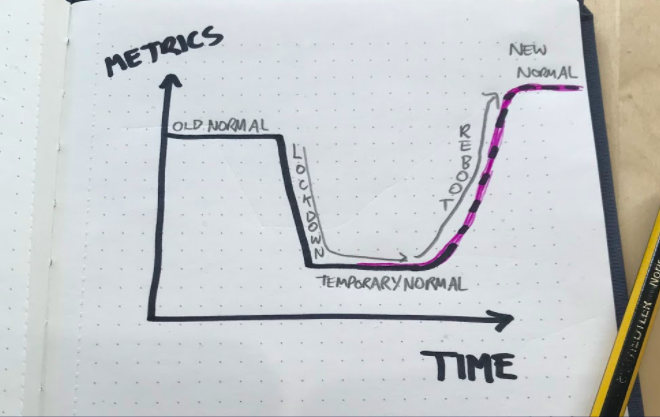If you’re anything like me, you’re still secretly wishing that the last month has all been a bad dream. In mid-March, reality flipped – suddenly people were panic buying toilet roll, hoarding hand sanitiser and wearing face masks on the Tube. Restaurant visits fell by 20%, 30% and then, in the third week of March, the government instructed restaurants, pubs and bars to close their doors altogether.
This has been, and continues to be, a uniquely challenging period for our industry – economically comparable to wartime. If you’ve made it this far with a measure of sanity, stop and give yourself a pat on the back. If not, join the club.
With such uncertainty about the future, it can feel impossible to begin planning for the return to normality – whatever normality looks like in a post-Covid world. At Vita Mojo, we have developed a handy model for doing this which has helped us immensely, and we hope might help you too. It’s called the Four Stages Model, and it looks like this:
Stage 1: Shock adjustment period (2-3 weeks)
Stage 2: Temporary ‘normal’ – life during lockdown (2-3 months)
Stage 3: Reboot – transition to new ‘normal’ (3-6 months)
Stage 4: New ‘normal’
Stage 1
Stage 1 we have, thankfully, passed through and finished. This was the period when Covid-19 went from being a far-off news story to an imminent crisis. We saw sudden, dramatic change, as restaurants closed and Boris Johnson told everyone to stay home. Productivity in all sectors took a nosedive as businesses were in shock, struggling to adapt. Operators were forced to make impossible and painful decisions, laying off staff they couldn’t afford to pay, with guests staying away, government support yet to be announced, and no clue what lay ahead. Tons of unsold food went to waste as supply chains halted. Basically, it was a mess.
Stage 2
Once the dust settled a little, we found ourselves in stage 2 – the temporary normal. This is when we stopped mourning, rolled up our sleeves and got to work. The industry saw campaigns to feed the NHS, breweries switching to produce hand sanitiser, and restaurants converted to mini supermarkets. Businesses started to adapt, planning how to survive this crisis, and do some good along the way. Consumers turned to low and no-contact food ordering, benefitting operators with established delivery and click & collect systems, and dark kitchens. Wholesalers and suppliers pivoted to sell direct-to-consumer with delivery. Some of these changes were temporary, suiting only a world in lockdown, but many will continue into the ‘new normal’, shaping the world for the future.
Stage 3
Stage 3 is what we call ‘reboot’, the transition back to the new normal. The end of lockdown will not be at the flick-of-a-switch, but a careful, gradual process that could last 3, or 6 months, or even longer. During this period, restaurants may start to reopen cautiously, adapting their operations to reduce human contact: delivery, click & collect, and socially-distant seated dining. Many, especially the vulnerable, will be reluctant to dine elbow-to-elbow with strangers for months, or even years, to come. Own-device ordering options will be preferred both for convenience and safety. For operators, this period will be a mixed bag. A proportion of the industry likely won’t make it this far, meaning gaps of opportunity left in the market. Those that are sensitive to the changed needs and expectations of the post-Covid customer may even find this to be a period of growth for their brand.
Stage 4
Finally, one day, we will make it to stage 4: the new normal. Quarantine will be a mere memory, and life will be as it once was… but, not. Unfortunately, it is unlikely to be a smooth ride for the restaurant industry. With the UK economy currently taking a severe beating, we should expect low economic growth for 2021-22. Margins will likely shrink even more and it will be essential to find ways to increase efficiencies and leverage technology to reduce costs. With consumers on-boarded to digital ordering, the role of cashiers and waiters will evolve and, in some cases, even disappear. Staff will need to add real value as brand ambassadors, while operations are managed more and more by technology. Digitising processes and embracing automation will enable operators to both reduce costs and offer lower-contact dining experiences while necessary. The concentration of demand is also likely to change, as remote working 1-2 days a week becomes the norm, reducing footfall in urban centres. This could mean a drop by 15-25% in sales for restaurants in transport hubs and office areas, while demand increases for delivery and click & collect in suburbs.
The shifts towards digitisation that were starting in the industry have been hugely accelerated under the pressures of the past few weeks. There will be no return to the old ‘normal’, instead a new world with new challenges and new opportunities is emerging. It is the restaurant operators who are realistic about this – who are ready for that world – who will thrive in it. I am reminded of this quote: “There are decades where nothing happens; and there are weeks where decades happen.” Vladimir L.
